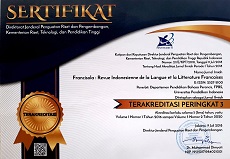A STUDY OF WOMEN’S LANGUAGE VARIETIES IN FRENCH MOVIE
Abstract
RÉSUMÉ. Cette étude traite les variétés de langues féminines dans un film français. Les objets de cette étude sont les énoncés de personnages féminins, à la fois dans le dialogue et le monologue. Cette étude vise à décrire les types de variétés de langue de la femme contenues dans le film, et les variants de la langue des femmes les plus fréquentes. La recherche a été menée en utilisant une approche qualitative où les données sont recueillies en utilisant des techniques d'observation et de prise de notes. Les données obtenues ont été tabulées en cartes de données afin de faciliter le processus d'analyse. Les résultats montrent qu'il y a 10 types de variétés de langue féminine apparues, à savoir lexical hedges or fillers, tag question, rising intonation on declaratives, ‘empty’ adjective, intensifiers, ‘hypercorrect’ grammar, super-polite forms, emphatic stress, gossip, and feedback. La variété la plus fréquente est intonation on declarative variety (50.9%) et celle la moins fréquente est lexical hedge or fillers (0.9%). Ce résultat devrait contribuer positivement au développement de l'étude sociolinguistique, en particulier sur l'étude de la variété des langues chez l'homme et chez la femme.
Mots-clés : film français, personnages féminins, sociolinguistique, variétés de langues féminines.
ABSTRACT. This study investigates women’s language varieties in a French movie. The objects of this study are the utterances of woman characters, both in dialogue and monologue. This study aims to describe the types of woman language varieties contained in the movie, and the most frequent variants of the woman language. The study was conducted using qualitative approach where the data gathered using observation and note-taking techniques. The obtained data were tabulated into data cards to facilitate the analysis process. The results show that there are 10 types of woman language varieties appeared, namely lexical hedges or fillers, tag question, rising intonation on declaratives, ‘empty’ adjective, intensifiers, ‘hypercorrect’ grammar, super-polite forms, emphatic stress, gossip, and feedback. The most appeared variety is rising intonation on declarative variety (50.9%) and the least appeared variety is lexical hedge or fillers (0.9%). This finding is expected to contribute positively in the development of sociolinguistics study, especially on the study of man and woman language variety.
Keywords: French movie, sociolinguistic, women’s language varieties, woman characters.
Full Text:
PDFReferences
Cuellar, S.B. (2006). Womens' language: a struggle to overcome inequality. Forma y Función, (19), 137-162. Retrieved from http://www.scielo.org.co/pdf/fyf/n19/n19a08.pdf
Couchane, A. M. S. (2016). Gender Language Differences Do men and women really speak differently? Global English-Oriented Research Journal, 2(2), 182–200. Retrieved from www.researchenglish.com
Ehrlich, S., Holmes, J., Meyerhoff, M. (2014). The Handbook of Language, Gender, and Sexuality. West Sussex, UK: John Wiley & Sons, Inc
Eliasoph, N. (2014). Politeness, Power, and Women’s Language: Rethinking Study in Language and Gender. Retrieved from http://dornsife.usc.edu/assets/sites/543/docs/Politeness_Power_and_Womens_Language.pdf
Haas, A. (1979). Male and Female Spoken Language Differences: Stereotypes and Evidence. Psychological Bulletin, 86(3), 615–626. Retrieved from https://pdfs.semanticscholar.org/0d20/2e5e05600222cc0c6f53504e046996fdd3c8.pdf
Holmes, J. (2013). An Introduction To Sociolinguistic (4rd. Ed). New York: Routledge.
Hirschman, L. (2016). Female-male differences in conversational interaction. Retrieved from https://static1.squarespace.com/static/5523ffe4e4b012b2c4ebd8fc/t/56e70b0fb09f95aecf94ee04/1457982223541/1994+-+Female-Male+Differences+in+Conversational+Interaction+-+Intro.pdf
Jakobsson, S. (2010). A study of female language features in same -sex conversation. Retrieved from http://www.diva-portal.org/smash/get/diva2:375135/fulltext01.pdf
Lakoff, R. 1975. Language and a Woman’s Place. New York : Harper and Row Publishers
Marvina. (n.d.). Women’s Language in "Wild Child" Movie. Retrieved from http://download.portalgaruda.org/article.php?article=142965&val=937
Mazidah, K. U. (2013). Women’s Speech Features Used By Character Margaret In The Iron Lady Movie. Language Horizon, 1(3), 1-5. Retrieved from http://jurnalmahasiswa.unesa.ac.id/index.php/language- horizon/article/view/3828
Merchant, K. (2012). How Men And Women Differ: Gender Differences in Communication Styles, Influence Tactics, and Leadership Styles. Retrieved from http://scholarship.claremont.edu/cmc_theses/513
Quellette. (1999). Les femmes en milieu universitaire. Canada : L’Université de l’Ottawa..
Schofield, A., & Mehr, L. (2016, June). Gender-Distinguishing Features in Film Dialogue. Paper presented at the Fifth Workshop on Computational Linguistics for Literature, NAACL-HLT 2016, San Diego, California, USA. Retrieved from http://aclweb.org/anthology/W16-0204West, C., Zimmerman, D.H., Quéré, L. (2000). Genre, langage et conversation. Réseaux. 18(103), 183-213.
Sundqvist, K. (2005). Gender Specific Language in Animated Movies. Retrieved from https://www.diva-portal.org/smash/get/diva2:517827/FULLTEXT01.pdf
Wayan, N., & Santi, A. (n.d.). Comparison of Sexist Language Used in The Twilight Saga Eclipse Movie. Retrieved from http://download.portalgaruda.org/article.php?article=121682&val=937
Yulaelawati, E. (2013). Bahasa dan Responsif Gender. Jakarta: Direktorat Pembinaan Pendidikan Masyarakat-Ditjen Pendidikan Anak Usia Dini, Nonformal, dan Informal-Kementerian Pendidikan dan Kebudayaan.
DOI: https://doi.org/10.17509/francisola.v2i2.9404
Refbacks
- There are currently no refbacks.
Copyright (c) 2017 FRANCISOLA

This work is licensed under a Creative Commons Attribution-ShareAlike 4.0 International License.
View My Stats










